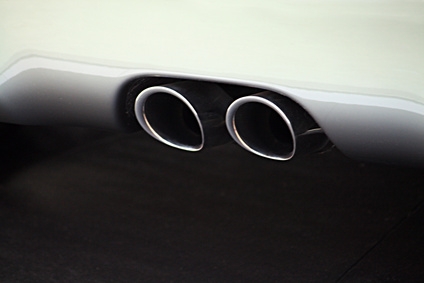
Prior to building exhaust components, you must first correctly size the individual components, such as the headers and the muffler, for optimal performance. Piping shape and diameter determines exhaust flow and velocity. In terms of diameter, overly small piping will constrict flow and reduce top-end engine power. Small piping does increase exhaust velocity. Excessively large piping allows maximum flow but reduces velocity, which greatly reduces torque without substantially increasing engine power. Exhaust shape and diameter also determine the amount of backpressure, which occurs when exhaust returns into the engine, reducing power and efficiency. Sizing an exhaust system varies by application.
Locate your vehicle's engine information in the owner manual or through the manufacturer. The number of cylinders, engine type, capacity and the engine's maximum revolutions per minute (RPM) are extremely important to sizing your exhaust system.
Write down the engine specifications, which will help formulate the optimal size and diameter of your headers. For example, Custom-Car suggests a 1600cc, 4-cylinder engine with a 5,500 RPM redline requires a primary pipe approximately 1.5 inches in diameter and between 34 and 36 inches in length.
Open the hood and locate the exhaust headers. The headers are bolted to the engine's cylinder ports and lead underneath the vehicle to the front pipe and muffler.
Measure the headers' piping length and diameter as a starting point for building your own.
Consult a performance exhaust builder in your area for more information on optimal headers sizing, which will vary by car and engine.
Determine a range of piping diameters and lengths based on the stock size of the headers. Later fabricate a version of each new size. If possible, test each on a dynamometer to find which design creates the best power output.
Lift the front of the vehicle with a hydraulic jack, place jack stands beneath it, and locate the muffler assembly. It is the large canister just before the tailpipe. Write down the muffler length and diameter.
Shop online for a performance muffler assembly specific to your vehicle. Purchase a muffler with a piping length and diameter that optimizes engine performance. Muffler brands provide technical data that states power readings comparing the stock assembly to the specific aftermarket assembly to highlight the power gains.
Minimize backpressure by selecting a muffler assembly with a flow capacity that corresponds to the flow capability of the engine. Refer to the manufacturer or a trusted mechanic for information on your engine's specific flow capability.
Decide how loud you want the exhaust to be. A free flowing muffler is louder than that with multiple chambers. Sound clips of specific muffler sounds may be provided on the company's website.
Consult a trusted mechanic before purchasing a muffler. Ask questions about the muffler design and how the internals will affect engine performance and sound.